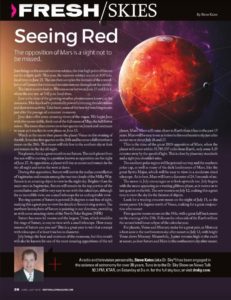Sights to see in the June and July 2018 skies
The opposition of Mars is a sight not to be missed.
By Steve Kates
June brings us the annual summer solstice, the true high point of the sun on the ecliptic path. This year, the summer solstice occurs at 3:07 a.m. local time on June 21. The sun then occupies the domain of the constellation of Gemini the twins and remains intense throughout the month.
The latest sunsets here in Arizona occur between June 27 and July 1, when the sun sets at 7:42 p.m. local time.
June is the time of the growing weather phenomenon known as the monsoon. Hot days lead to potentially powerful evening thunderstorms and dust storm activity. Take heart, some of the best sky watching occurs just after the passage of a summer monsoon.
June skies offer some amazing views of the moon. We begin June with the moon visible, fresh out of the full moon of May, the full flower moon. The moon then moves on to last quarter on June 6 and continues to wane as it reaches its new phase on June 13.
Watch as the moon then passes the planet Venus on the evening of the 6th. It reaches first quarter on the 20th and becomes a full strawberry moon on the 28th. This moon will ride low in the southern sky at dusk and remain in the sky all night.
For planets, this is a great month to see Saturn. The sixth planet from the sun will be moving to a position known as opposition on the night of June 27. At opposition, a planet will rise at sunset and remain in the sky all night and set in the west at dawn.
During this opposition, Saturn will nest in the zodiac constellation of Sagittarius and remain among the vast star clouds of the Milky Way. Saturn is an amazing object to view in the night sky. Brighter than the main stars in Sagittarius, Saturn will remain in the top portion of the constellation and will be very easy to see with the naked eye, although for an incredible view, use a small telescope for an unforgettable view.
The ring system of Saturn is pointed 26 degrees to our line of sight, making this a great year to view the details in Saturn’s ring system. The northern hemisphere of Saturn is pointing in our direction, providing us with some amazing views of the North Polar Region (NPR). Saturn has some 62 moons and the largest, Titan, which straddles the rings of Saturn, is easy to view with a small telescope. How many moons of Saturn can you see? This is a great year to test that concept with telescopes of at least 6 inches in diameter.
July brings the heat and moisture of the monsoon, but this month will also be known for one of the most amazing apparitions of the red planet, Mars. Mars will come closer to Earth than it has in the past 15 years. Mars will be easy to see as it rises in the southeastern sky just after sunset on or about July 26 and 27.
This is the time of the great 2018 opposition of Mars, when the planet will come within 35,785,537 miles from Earth, only some 3.25 minutes away by the speed of light. This is close by planetary standards and a sight you shouldn’t miss.
The southern polar region will be pointed our way and the southern polar cap, as well as many of the dark landmasses of Mars, like the great Syrtis Major, which will be easy to view in a moderate sized telescope. At its best, Mars will have a diameter of 24.3 seconds of arc.
The moon in July encourages us to look upwards too. July begins with the moon appearing as a waning gibbous phase, as it moves on to last quarter on the 6th. The new moon is on July 12, making this a great time to view the sky for the faintest of objects. Look for a waxing crescent moon on the night of July 15, as the moon passes 1.6 degrees north of Venus, making for a great conjunction after sunset. First quarter moon occurs on the 19th, with a great full buck moon on the evening of the 27th. Folks on the other side of the Earth will see the second total lunar eclipse of the calendar year.
For planets, Venus and Mercury make for a great pair, as Mercury is best seen in the northwestern sky after sunset on July 12, with bright Venus above Mercury. Meanwhile, Jupiter remains high in the south at sunset, as does Saturn and Mars in the southeastern sky after sunset.
Related posts
Leave a Comment
You must be logged in to post a comment.







